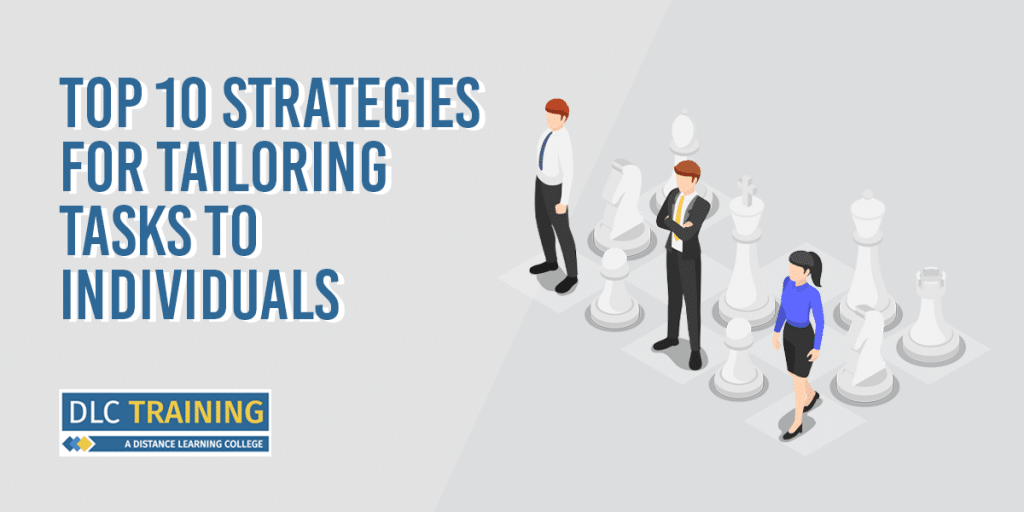Engaged and productive employees are key to reaching objectives and driving the business towards success. However, research has found that only 36% of employees are actually engaged within the workplace. While this percentage is low, it reflects the fact that every employee has different personalities, motivations, skills, and interests. This ultimately results in different aspects of work being suitable for different people. To ensure all employees are engaged, leaders should prioritise strategies for tailoring roles and tasks to suit the individual strengths of every employee.

If you have noticed that an employee’s strengths don’t quite fit the role they have, or the project/task they are working on, it may be time to tailor that role or task.
Strategies for Tailoring Roles
Adapting roles and tasks to suit employees’ skill set, capabilities, and strengths is essential for fostering a positive work environment, it both maximises productivity and promotes employee satisfaction. Discover below the ten strategies for tailoring roles and tasks to maximise employee talent.
- Analyse and Understand
- Professional Development
- Encourage Ownership
- Empower Through Autonomy
- Promote Collaboration
- Monitor Workload
- Flexibility and Adaptability
- Provide Feedback
- Tailor Responsibilities
- Have Processes in Place
Analyse and Understand
Firstly, it’s important to take time to properly understand each employee’s personality, skills, strengths, and weaknesses. Carrying out regular performance reviews will enable you to evaluate performance, successes and challenges. It will also enhance and encourage manager-employee communication.
Professional Development
Through the availability of training and development opportunities, employees will acquire the skills and knowledge required for their roles. This will enhance their capabilities while preparing them for future progression.
Encourage Ownership
When employees have ownership of their tasks, they are more likely to be concerned with the quality of the work that they produce. This will result in higher engagement as well as commitment to achieving the company’s goals.
Empower Through Autonomy
Although providing employees with autonomy over how they execute their tasks requires trust and confidence in their abilities, it creates a sense of empowerment, enabling them to feel more in control of their work processes and outcomes.
Promote Collaboration
Encouraging teamwork where employees collaborate towards a shared goal not only creates a cohesive work environment but also enables the exchange of skills and knowledge among team members. By pooling their expertise and experiences, individuals within the team can learn from one another, fostering professional growth while collectively driving towards organisational success.
Monitor Workload
Being aware of your employee’s workload and adjusting accordingly will prevent stress and burnout. If any challenges are identified, then tactics such as reallocation of tasks and deploying additional resources can be implemented. This will mitigate workload burdens and ensure optimal productivity.
Flexibility and Adaptability
Provide opportunities for employees to take on new challenges and responsibilities that align with their strengths. Offer flexibility with task allocation to accommodate individual preferences while taking into account their strengths.
Provide Feedback
Providing regular feedback, recognising achievements, and providing guidance will help you support your team members with identifying areas for improvement and any potential skill gaps. It will also establish key strengths, enabling you to make better decisions when allocating tasks to individuals.
Tailor Responsibilities
Allow employees to align their responsibilities with their strengths and interests. This could involve adjusting job responsibilities, tasks, or projects to capitalise on individual talents. Allowing employees to tailor their role will boost engagement and job satisfaction. As individuals will be allocated to roles and tasks that are better suited to their strengths and interests, it will also ensure tasks are completed to the highest standard.
Have Processes in Place
Have clear processes in place that are communicated accordingly throughout the organisation. This will ensure that the points raised above will have a positive impact on both individuals and the business as whole.
Our CEO’s Perspective
The strategies above have been tried and tested. Jacky Stansfield Smith, CEO at DLC Training, has implemented these strategies within the organisation. She stated, “In my experience, an organisation with processes in place which allow for the assignment of tasks and responsibilities based on each team members strengths and interests leads to increased engagement, productivity, and motivation. Recognising the importance of tailoring responsibilities to match the unique talents of each team member enables us as an organisation to maximise individual talent while enhancing the effectiveness and productivity of the whole team. Within our organisation, each team member is motivated to contribute to the best of their abilities, which leads to a cohesive and high-performing team.”
By implementing these strategies, organisations can create a more dynamic and adaptive work environment where employees feel empowered to contribute their best and achieve greater success in their roles.
Interested in learning more about leadership? Read our blog about the top ten characteristics of effective leadership. If you would like to take your career to the next level, discover our online training courses in leadership and management.